|
Ruger introduced the
Model 10/22 carbine way back in 1964. It was a rimfire rifle
that replicated the looks and feel of their .44 Magnum carbine.
Using a die-cast aluminum receiver and a ten-shot rotary
magazine, it was different from any other rimfire rifle on the
market. Forty-five years later, Ruger has sold over 5.7 million
of the little jewels, and the 10/22 is as popular today as it
has ever been. Ruger currently catalogs 35 different variations
of the 10/22; blued or stainless steel, wood or polymer stocks,
various barrel lengths, and even a couple of models with pink
stocks that are popular with the ladies. Still, the heart of the
10/22 is the rugged and reliable action, operating as a simple
blowback and still using the excellent rotary magazine. Other
manufacturers produce some pretty good semi-auto twenty-twos,
but the Ruger still outsells them by a wide margin. The 10/22 is
not the least expensive .22 auto on the market, but it does sell
at a very affordable price. The basic 10/22 RB can still be
found at Wal Mart stores for under 200 bucks. There are a couple
of other good twenty-two autos that have also been around for as
long as the Ruger. The fine Remington Model 552 is still in
production, but costs twice what the 10/22 does. The Marlin
Model 60 is another very good .22 auto, and is still available,
but is not as popular as is the Ruger. Browning still makes
their trim little auto, but it too is higher priced and not as
popular. All three of these use tubular magazines, but the Ruger
has that reliable and compact rotary box magazine that is simple
to use, and easily replaced with another loaded mag when empty.
Well over five million rifles in forty-five years is a huge
success for any rifle maker, but Ruger has done this with just
their .22 auto, while still producing their extensive line of
centerfire rifles, pistols, revolvers, and shotguns as well.
While the variations of the 10/22 offered
should be enough to satisfy any shooter, the basic 10/22 RB has
been the backbone of the line since its inception. The basic
style of the 10/22 RB is pretty much unchanged from the early
rifles, but some changes in material and manufacture have taken
place over the years. Ruger now produces their 10/22 barrels
using the hammer-forged method, which produces a barrel of
exceptional quality. A short length of drilled barrel steel is
placed over a carbide mandrel which has the reverse of the
rifling milled into its surface. The barrel is then fed into the
machine, which hammers the barrel into a longer length, while
impressing the rifling into the finished bore. The barrels are
then outside-turned to shape, or left as-is and surface finished
for the bull-barrel target models.
Another change in production which took place
a few months ago was a change in the material used in the
trigger housing, which also incorporates the trigger guard. For
most of the rifle’s life, this part has been made of aluminum.
However, it is now made of polymer. It used to be that
“plastic” meant “cheap”, and when a gun manufacturer
went with a plastic part, it was done solely to save material
costs. Today, this is not the case. High tech plastics have been
used for many years to make gun parts, and in many cases, they
are stronger and tougher than their aluminum counterparts. A
good example is in AR-15 magazines. The traditional material for
these is aluminum, but today polymer magazines are available
that are much more durable than the aluminum mags. They also
cost more than the aluminum magazines. Still, shooters, myself
included, wanted to know why Ruger went from aluminum to polymer
on the 10/22 trigger housing, so I asked. Ruger can do an
aluminum trigger housing or a polymer one for about the same
cost per unit. However, the aluminum parts are not consistent,
so a whole rack of different small parts had to be stocked to
accommodate the wide tolerances within that aluminum part.
Trigger pulls were not consistent from rifle to rifle, and Ruger
sought a better way. Ruger engineers tell me that the polymer
housing is so consistent from part to part that they now only
have one set of small parts for the internals of the trigger
group, and that trigger pulls are very consistent from rifle to
rifle. The polymer trigger housing/trigger guard comes out of
the mold pretty much ready to go into the rifle. What surprised
me was that they told me that the polymer trigger guard was
tougher as well, and would not suffer damage if dropped to the
extent that the aluminum unit did. They had tested this in a
controlled environment, delivering the same blow to both parts,
and the aluminum parts were damaged to a much greater extent
than were the polymer parts. I wanted to see this for myself, so
I went to the factory in New Hampshire to observe this
firsthand.
Ruger has a fixture set up to do their drop
tests on revolvers and pistols. We used this same fixture to
drop a four and one-half pound weight directly upon the trigger
guard portions of both the aluminum and polymer trigger
housings. The video shows the results clearly. A standard 10/22
RB weighs in at about five pounds, so this 4.5 pound steel
weight pretty much replicates what would happen to a 10/22 rifle
if dropped directly upon its trigger guard onto a solid surface,
such as steel or concrete. As the video and pictures show, the
polymer unit takes the abuse much better than does its aluminum
counterpart. From a height of two feet, the aluminum unit was
badly bent. The polymer unit was undamaged. From three feet, the
aluminum unit was cracked, and bent in enough to render the
rifle inoperable. The polymer unit was only scratched. From four
feet, the aluminum unit shattered, and the polymer unit suffered
a small crack, but was still serviceable, and would not impede
the operation of the rifle at all. Also, this was the same
polymer unit that had already endured the two foot and three
foot drops. We had to use a new aluminum unit for each of the
tests. I was convinced. The polymer trigger housing is much
tougher than the aluminum part. Still, being a traditionalist,
old habits die hard for me. However, I do have to admit that
realistically, polymer was the right choice that for that part,
and is an improvement over the aluminum part, even if I do hate
to admit it. Another plus for the polymer is that if it is
scratched, it is the same color underneath, whereas the aluminum
shows a scratch vividly.
Other than those two changes; the barrel
making method and the polymer trigger housing, along with a
polymer barrel band on those models which incorporate the use of
one, the 10/22 is pretty much unchanged over the years. Ruger
still makes their own wooden stocks, and sands and finishes them
in-house as well. The 10/22 that I just received is little
changed from a new one that I have here that I bought for my
wife twenty years ago. It was our tenth anniversary, and we were
married on the 22nd of December, so the Ruger 10/22
seemed like the perfect anniversary gift to me. She wasn’t as
impressed as I had hoped that she would be, but my wife is not a
shooter, and does not fully appreciate a firearm as much as I
do. To her, a gun is just another tool to get a job done when
needed. Y’all please pray for her.
The 10/22 is one of those rifles that
everyone should own, and fits well into any firearm battery.
Truth is, I can do ninety-five percent of what I need to do with
a rifle using a good twenty-two. Most of us could. The 10/22 is
a perfect plinker, plenty accurate for shooting small game, and
if needed, could serve pretty well for defending the home from
an attacker. A .22 Long Rifle bullet will penetrate pretty well
when fired from a rifle barrel, and with the 10/22, a person
could quickly and accurately send a barrage of bullets into an
attacker.
The aftermarket is flush with parts to easily
customize the 10/22, if desired. At least for now, extended
magazines holding 25, 30 or even 50 rounds are available at a
reasonable price. The excellent little ten-round factory
magazines are plentiful, reliable, and fit flush with the bottom
of the receiver. Barrels and stocks are available to configure
your basic 10/22 any way that you like, or if preferred, Ruger
probably builds a 10/22 that will fill every need, from hunting
to plinking to full-blown competition. On the competitive
circuit, the 10/22 dominates the field. On the range and in the
field, millions of shooters and hunters rely upon the 10/22
everyday. It is an American icon, American made, and readily
available anywhere that guns are sold.
Check out the full line of Ruger products
here.
For the location of a Ruger dealer near you,
click on the DEALER FINDER at www.lipseys.com.
To order the 10/22 online, go to www.galleryofguns.com.
Jeff
Quinn
| For a list of dealers where you can
buy this gun, go to: |
|
To buy this gun online, go to: |
 |
|
 |
|
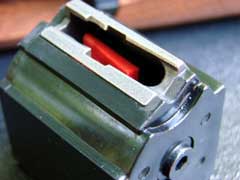
The rotary magazine is the heart of the 10/22
action.
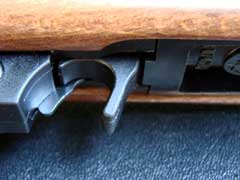
All 10/22s now come with an extended magazine
release.

Applying serial numbers to 10/22 receivers.
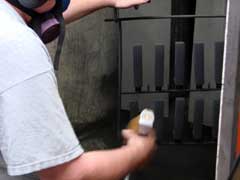

Powder-coating 10/22 receivers.
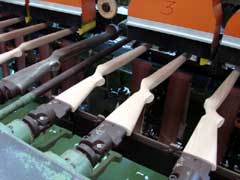
Pantograph machine turning 10/22 stocks.
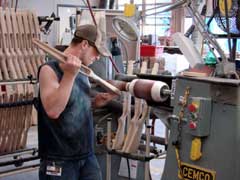
Sanding stocks.
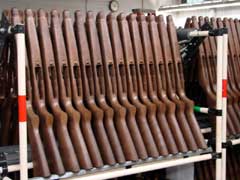
Finished 10/22 stocks.
|
  
Got something to say about this article?
Want to agree (or disagree) with it? Click the following link to
go to the GUNBlast Feedback Page.
|
|
Click pictures for a larger version.
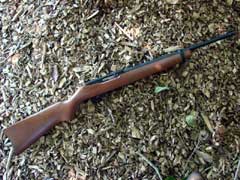
Ruger 10/22 Carbine.
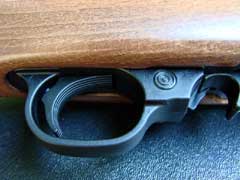
New polymer trigger housing.
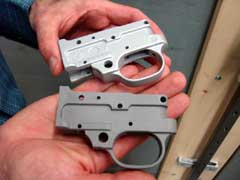
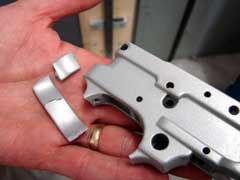
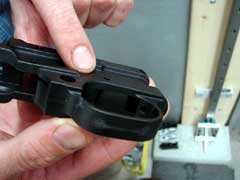
Aluminum trigger housing (top) and polymer trigger
housing (bottom) after four-foot drop test.
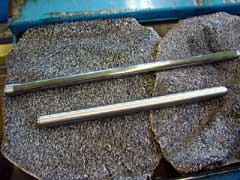
10/22 barrel before and after hammer forging.

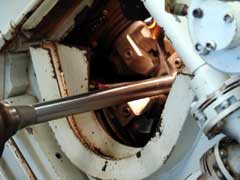
Hammer forging machine.
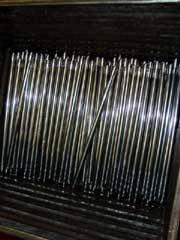
10/22 barrels ready for outside contouring.
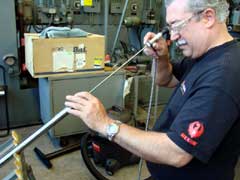
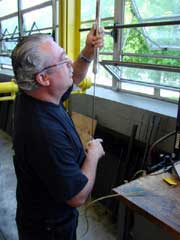
Ruger employee inspecting and air-gauging a 10/22
barrel.
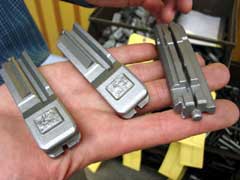
Cast 10/22 bolts.
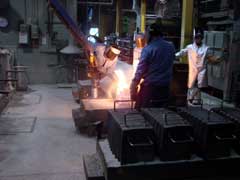
Ruger employees casting parts.

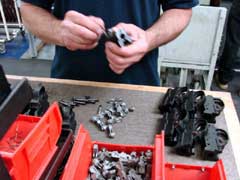
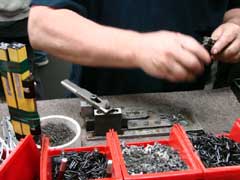
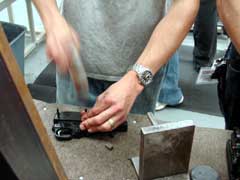
Assembling 10/22 rifles.
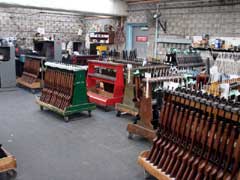
10/22 rifles ready for test firing.
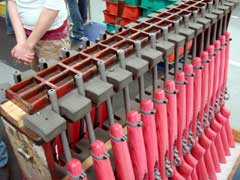
Rack of pink 10/22s.
|
![]()